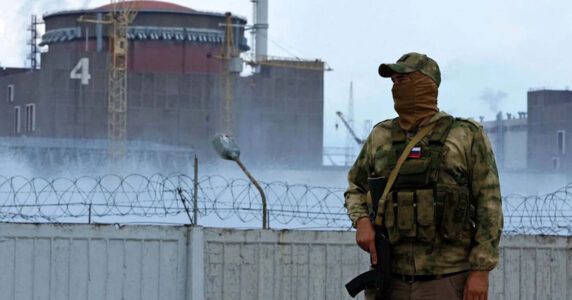Navigation and useful materials
After the blow-up of the Kakhovka HPP, it became obvious that the occupiers do not consider the damage they cause to the environment of Ukraine. However, we should not forget that the war and related environmental problems began in 2014.
The Centre for Strategic Communication and Information Security recalls the environmental problems of Ukraine, caused by the aggressor even before the start of the full-scale invasion.
Flooding of mines in the east of Ukraine
One of the main issues after Russia unleashed hostilities in the east of Ukraine, with its industrial zone, in particular, chemical enterprises, was the flooding of mines. Many mines in the occupied areas of Luhansk and Donetsk oblast stopped pumping water.
Within the project of the French humanitarian organization ACTED, as reported by Radio Liberty, 20 samples of groundwater were taken in Toretsk and in the surrounding mines — samples of mine groundwater, from boreholes and from wells. Only two of the twenty samples were close to drinking water standards. Mine waters contained toxic elements, whose concentration exceeded the permissible indicators even for household waters. The analysis of water and soils was carried out by specialists of the state enterprise Donetskgeology. They found that further flooding of mines in the area could lead, in particular, to the release of mine waters of increased mineralization on an area of 1,400 hectares, which would lead to waterlogging and salinization of soils, as well as to a deterioration in the quality of groundwater.
Among others, the Yunyi Komunar mine was flooded, where an experimental underground nuclear explosion was carried out in 1979. Since 2014, this mine, located near the village of Bunhe, has been under Russian occupation. The termination of water discharge on it occurred on April 14, 2019 without the consent of the IAEA and the State Nuclear Regulatory Inspectorate of Ukraine. The facility has been transferred from “dry” to “wet” preservation.
The level of radioactivity in mines and mine waters during the observation period in 1979–2000 was at a background level, but flooding creates new risks. According to the Ministry of Environmental Protection and Natural Resources of Ukraine, the cessation of water discharge threatens the release of artificial radionuclides to the surface, which can be contained in the capsule: strontium-137, cesium-90, and plutonium-239.
In addition, the ingress of radioactive liquid into groundwater threatens to contaminate the ecosystem of the Sea of Azov. The option of conservation, which was chosen by the Russian occupation administration, is environmentally dangerous because it can lead to repeated contamination with radionuclides.
In a commentary to the Centre for Strategic Communication, Roman Filonenko, head of the Department of Waste Management and Environmental Safety, told that Ukraine, since 2014, raised questions, in particular, about the pollution of underwater waters and soils in the Trilateral Contact Group on Peaceful Settlement mediated by the OSCE. But representatives from Russia and puppet administrations from the so-called “DPR” and “LPR” blocked Ukraine’s attempts to introduce environmental monitoring of the occupied territories under various pretexts, denying access to Ukrainian and international experts.
Only when, as a result of the flooding of the mines of the occupied territories, the groundwater was carried out by contaminated mineralized waters also to the territory of Russia, and the water quality in the wells of Rostov Oblast significantly deteriorated, Russians agreed to the admission of international experts. However, after the beginning of the full-scale invasion, this issue was put on pause.
Another idea promoted by Ukraine in the Trilateral Contact Group was the creation of a number of “safety islands” around dangerous enterprises, for example, at the Coke and Chemical Plant, Donetsk State Plant of Chemical Products, or at the Stirol Concern. Experts should appear there to conduct an audit, and in the area around — a more significant withdrawal of troops should be organized to reduce shelling and avoid emergencies. The Russian side rejected this initiative as well.
Emissions on the Crimean Titan
In the occupied east of Ukraine, the OSCE and the special monitoring mission worked and performed at least some functions; however, as far as Crimea was concerned, Russians did not allow anyone into the occupied peninsula, emphasizing that it was exclusively an internal affair of Russia.
However, the occupiers could not conceal the environmental problems they created from the world. Thus, in August and September 2018, emissions of toxic substances from acid storage at the Crimean Titan enterprise in Armiansk were recorded. On August 31, 2018, the State Environmental Inspectorate found twice the concentration of sulphates in the soil near the administrative border of Kherson Oblast with Crimea. Only 18 days after the first release did the occupation administration announce the evacuation of children from Armiansk.
In March 2019, another powerful release of a toxic substance occurred at the plant’s acid accumulator, which was under a layer of phosphogypsum and a “water lock.” According to locals, a strong evaporation of chemicals was observed in the area of the acid accumulator, which was carried by the wind to residential areas of Armiansk and surrounding settlements. Plant employees were given respiratory protection when working on shifts.
A similar emission occurred in August 2019. Then the occupation authorities of Crimea concealed the fact of chemical emissions. Each of the cases was accompanied by a sharp deterioration in the health of locals. Mass appeals of residents of the occupied Dzhankoi and Krasnohvardiiske districts to hospitals were recorded; in 2019, there were frequent facts of the birth of children with developmental disabilities.
According to ecologists from the public organization Environment People Law (EPL), the cause of pollution in 2018 was the sedimentation pond, where the waste of the sulphur section of the plant was stored, including waste sulphuric acid. The sedimentation pond had to be irrigated with water daily, as regular watering was important for the safe maintenance of the sedimentation pond. However, the administration of the plant did not ensure such a water supply.
Drying of the pond is the evaporation of water from the solution and the entry into the air of sulphur dioxide, which is an acid gas and, upon contact with water, can again form an acid. This happens due to the reaction with drops of water in the fog, with dew on the surface of plants, with drops of sweat on human skin, or with the mucous membrane of the eyes, nose, oral cavity, trachea, bronchus.
People in the areas contaminated by the accident complained of problems with the respiratory system, eyes and allergic reactions. The residents of Armiansk and the Perekop village in Crimea suffered the most, as well as residents of the Preobrazhenka village in Kherson Oblast. Ukrainian border guards on the isthmus also sought medical help.
In addition to the impact on human health, the acidic environment affects the environment. Plants get chemical burns and soon die or dry out. Most of the crops in the above areas are contaminated and lost.
Soils contaminated with shells and burned forests
Another environmental issue since 2014 has been soil contamination from landmines and shells. EPL ecologists believe that in places of exploding shells, it is impossible to grow crops for food production because heavy metals and sulphur compounds enter the formed tears. The inspected tears from explosions revealed increased concentrations of cadmium, lead, nickel, zinc, chromium, cobalt, copper, vanadium, titanium, manganese, strontium, iron, zirconium, tin, gallium, and yttrium.
For example, in 2018, ecologists studied the place of the largest concentration of tears (more than 15,000) in the fields near Savurivka in Donetsk Oblast, where the soil contained at least 10 tons of sulphur. According to EPL experts, at least 225 square kilometres in the places of battles for Savur-Mohyla became unsuitable for use in agriculture.
Another problem is the destruction of protected forests by war. According to EPL, in 2014 alone, during the battles for Sloviansk, about 1,000 hectares of the Holy Mountain National Nature Park were damaged by Grad shelling. Then the fire took up about half the area of regional landscape parks, of which at least 50% are forests (up to 1,800 hectares).
“The damage to the protected areas that we found is caused by three main factors: shelling, passage of heavy equipment, and fires caused by explosions of ammunition and intentional arson,” explains EPL ecologist Oleksii Vasyliuk.
In accordance with the Resolution of the Cabinet of Ministers of Ukraine of July 24, 2013 No. 541, a tax was approved to calculate the amount of damage caused by violation of the legislation on the nature reserve fund. It indicated that, according to the estimates of the EPL, on November 3, 2014, the amount of losses due to protected forests alone destroyed by the war amounted to UAH 13.9 mln.
At the end of 2021, the Ministry of Environmental Protection and Natural Resources of Ukraine took the initiative to international organizations, in particular UNEP, UNDP, UNIDO, with a proposal to develop methods for assessing the damage caused to the environment of Ukraine by the aggression of Russia for the preparation of claim materials for their recovery. Then the position of the Ukrainian side was not perceived well, and some organizations in the letters expressed statements that could be considered as playing into the hands of Russia.
Soon, the full-scale invasion of Russia began and the amount of damage caused to the Ukrainian environment increased many times.
READ ALSO: Flooded Land and Burned Forests. How Russians Fight against Environment in Ukraine
Centre for Strategic Communication and Information Security
If you have found a spelling error, please, notify us by selecting that text and pressing Ctrl+Enter.



